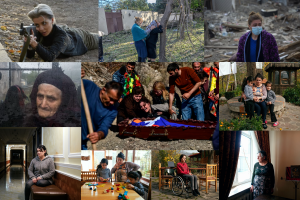Postcard 1: Map of Nagorno-Karabakh

This is a very simple map showing one understanding of the borders of Nagorno-Karabakh as it exists within Azerbaijan and near Armenia. The physical location of Nagorno-Karabakh, as it is literally caught in the middle of Azerbaijan and Armenia, has been essential to its experience of persistent violence. This map is also an incredibly simplistic one, offering very sparse amounts of information. Maps can be found of Nagorno-Karabakh which feature the progression of violence, movement of troops, sections of borders which are disputed, or even which show illustrations of tanks and soldiers overrunning the region. Less often, maps can be found which highlight the features of Nagorno-Karabakh rather than showing it just as a region of Nagorno-Karabakh. The borders of Nagorno-Karabakh differ slightly depending on the map that you look at, which seems insignificant at just a glance but it is anything but to the people who might live along the edges. Maps and borders are often thought of as objective sources of information, and yet they are so often inconsistent.
Instead of using any of these more complex maps of the region in order to communicate more information, I opted for the most simplistic map I could find. Perhaps, in some cases, the communication of information about a region should not be left to a map. Selecting this image was my way of acknowledging and leaning into the informational limitations that maps embody.
Sources:
Aljazeera, 2021. https://www.aljazeera.com/news/2021/11/16/armenia-azerbaijan-say-clashes-erupt-at-border
Postcard 2: A Mountain Region of Conflict

This postcard is meant to mimic the style of a postcard that might be available for purchase to feature a certain region. The image used in this postcard is of a group of people taking refuge in a bomb shelter in Stepanakert on October 6, 2020. Stepanakert is a prominent city within Nagorno-Karabakh and is, by some, considered the unofficial capital.
The selection of this image as a representation of Nagorno-Karabakh is done to highlight the experience of violence for the people within the region, rather than for the Azerbaijani or Armenian people/soldiers, as they are so frequently centered.
The composition of the bomb shelter as a mirror image of two half circles can be visually reflective of the desire to pull Nagorno Karabakh towards either Armenia or Azerbaijan, rather than considering it as its own entity.
The caption of the postcard, “Greetings from a mountain region of conflict” is meant to reference the tendency in news media to discuss Nagorno-Karabakh primarily as it relates to conflict and without naming and acknowledging it. “A mountain region” specifically is a reference to a NYTimes article, “Understanding the Fight Between Armenia and Azerbaijan”, the byline of which reads: “The hostilities that flared again last week reflect decades of animosity over a mountain region, but the consequences could be far wider”.
Sources:
Dmitri Lovetsky 2020, https://www.theatlantic.com/photo/2020/11/photos-2020-nagorno-karabakh-war/617123/#img04
Postcard 3: Women in Conflict in Nagorno-Karabakh

This is a collage of, primarily women from Nagorno-Karabakh, but more generally women who have been affected by the violence in and over Nagorno-Karabakh. Women are too often left out of the discussion of violent conflict or selectively included for their role as mothers and caretakers, relating to their perceived contribution to a nationalistic cause. This results in a frequently incomplete representation of their experiences, individuality, and autonomy.
These photos all only capture a moment in these women’s lives. This collage is meant to draw attention to the experience of women as individuals and human beings who have lived and are living through turmoil. It is not meant to simplify their experiences to what is captured in these photos or to be used for reductive narratives which would use women as props or argument bolsters. The two articles linked below offer greater, complex insight into the experiences of the women featured.
Sources and the women of these images:
Top left: Military Training course in Yerevan, 2020.
Karen Minasyan. AFP, Getty. https://www.theatlantic.com/photo/2020/11/photos-2020-nagorno-karabakh-war/617123/#img04
Top Center: “Women react at a blast site hit by a rocket… in the city of Ganja”
Bulent Kilic, 2020. AFP, Getty. https://www.theatlantic.com/photo/2020/11/photos-2020-nagorno-karabakh-war/617123/#img04
Top Right: Saire Guliyeva
Arif Hudaverdi Yaman 2020. Anadolu Agency, Getty. https://www.theatlantic.com/photo/2020/11/photos-2020-nagorno-karabakh-war/617123/#img04
Middle Left: Vartanush Avakyan
Brendan Hoffman, 2020. Getty. https://www.theatlantic.com/photo/2020/11/photos-2020-nagorno-karabakh-war/617123/#img04
Middle Center: “A mother mourns above a coffin with the body of her son in Stepanakert”
Aris Messinis, 2020. AFP, Getty. https://www.theatlantic.com/photo/2020/11/photos-2020-nagorno-karabakh-war/617123/#img04
Middle right: Francesco Bremati
Francesco Bremati is a photojournalist who authored an article discussing the experience of women displaced from Nagorno Karabakh, and who took a number of the images featured in this collage.
Francesco Bremati, 2020. https://www.thelily.com/war-has-left-these-armenian-womens-lives-in-limbo-we-are-not-home-and-i-miss-my-home/
Bottom left: Irina Israyelyan
While originally from Stepanakert, when photographed here in 2020 she was living in Goris, Armenia. She said, “I’m afraid of going back because we are surrounded by enemies.”
Francesco Bremati, 2020. https://www.thelily.com/war-has-left-these-armenian-womens-lives-in-limbo-we-are-not-home-and-i-miss-my-home/
Bottom Second: Anushik Movsisyan and daughters Marta and Mery
Francesco Bremati, 2020. https://www.thelily.com/war-has-left-these-armenian-womens-lives-in-limbo-we-are-not-home-and-i-miss-my-home/
Bottom Third: Arpine Harulyunyan
Francesco Bremati, 2020. https://www.thelily.com/war-has-left-these-armenian-womens-lives-in-limbo-we-are-not-home-and-i-miss-my-home/
Bottom right: Serpuhi Ghulian
When discussing the help she has received after fleeing to Armenia she said, “But we are not home, and I miss my home and the peace and the tranquility we had there. I miss my sons most of all.”
Francesco Bremati, 2020. https://www.thelily.com/war-has-left-these-armenian-womens-lives-in-limbo-we-are-not-home-and-i-miss-my-home
